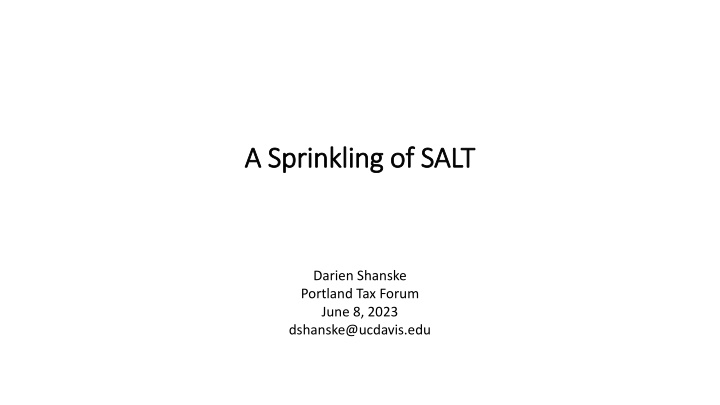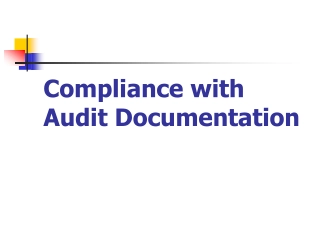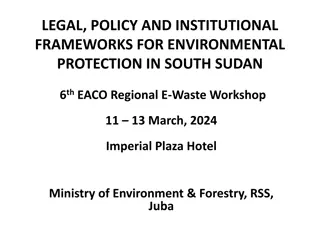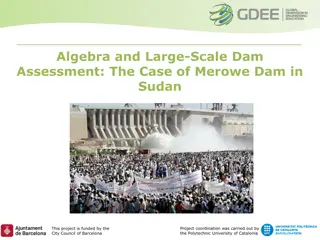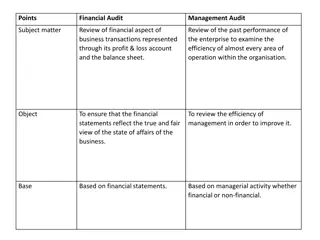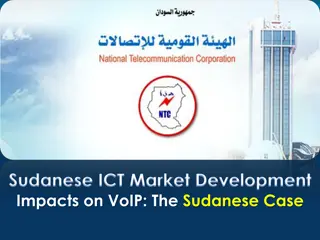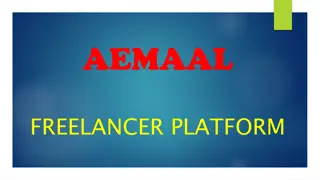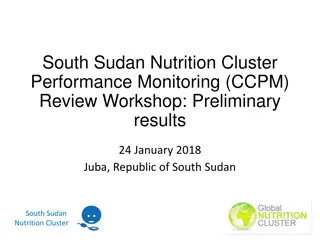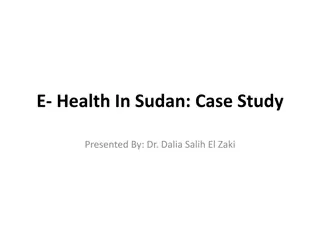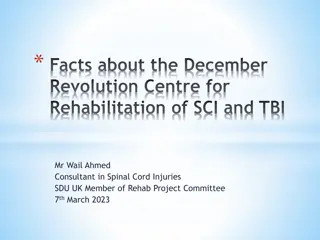Republic of the Sudan: Environmental Audit Experience
National Audit Chamber in Sudan has a rich history in environmental auditing, supported by a strong legal framework and international commitments. Learn about NAC's evolution in environmental auditing, organizational position, and strategic approach. Explore how NAC is building capacity and forging partnerships to address significant environmental challenges.
Download Presentation

Please find below an Image/Link to download the presentation.
The content on the website is provided AS IS for your information and personal use only. It may not be sold, licensed, or shared on other websites without obtaining consent from the author.If you encounter any issues during the download, it is possible that the publisher has removed the file from their server.
You are allowed to download the files provided on this website for personal or commercial use, subject to the condition that they are used lawfully. All files are the property of their respective owners.
The content on the website is provided AS IS for your information and personal use only. It may not be sold, licensed, or shared on other websites without obtaining consent from the author.
E N D
Presentation Transcript
A Sprinkling of SALT A Sprinkling of SALT Darien Shanske Portland Tax Forum June 8, 2023 dshanske@ucdavis.edu
Agenda Big picture Supreme Court State tax policy trends Maryland s Digital Ad Tax Digital goods and the sales tax PL 86-272 Residence issues Corporate issues GILTI, WWCR and CAMT Sourcing Partnership issues
National Pork Producers v. Ross This case involved national pork producers challenging a California law concerning the humane treatment of pigs. The plaintiffs lost on two claims. Extraterritoriality doctrine: There are a handful of SCOTUS cases that struck down state laws for their extraterritorial effect. It has come up in SALT litigation, including in Wayfair, where it was ignored. This doctrine never made much sense (to me) and all the justices disavowed it. Pike balancing. Two justices are apparently done with Pike (Gorsuch, Thomas); one virtually done (Barrett) and six want to keep it but none agree on how to do it. This additional confusion is important because (by my lights) Pike balancing is part of the analysis for state regulation of out-of-state vendors in connection with use taxes.
States are going their separate ways Many states have been and are cutting taxes, e.g., Florida, North Carolina. And some cuts are structural: 2022 will see at least four states move from a progressive personal income tax system with multiple tax brackets to an income tax code with one flat rate. https://www.forbes.com/sites/patrickgleason/2022/06/07/how-the- flat-tax-revolution-of-2022-was-sparked-in-north-carolina/?sh=2dffe0da789c Other states are going the other way: E.g., Ma s millionaire tax, Wa s tax on capital gains and Minnesota conformity to GILTI.
But are they all going to the same place? Preliminary data for the first quarter of 2023 indicate substantial weakness in overall state tax revenue collections, as well as in major sources of state tax revenues. This weakness was expected and is partly in response to state policy actions, including tax rate cuts and rebate payments. Total state tax revenues declined 8.8 percent in nominal terms and 13.4 percent in real terms int the first quarter of 2023 compared with the same period in 2022. - https://www.urban.org/research/publication/state-tax-and- economic-review-2022-quarter-4
Marylands DST 2.5% to 10% tax on global annual gross revenues earned on digital advertising in Maryland. Rate increases with worldwide gross revenue. Expected to raise $250mn annually. Revenue dedicated to package of education reforms, including expanding Pre-K. Challenged in both federal and state court. Fed Ct dismisses most of suit on TIA grounds; now on appeal. [taxprofs filed an amicus brief with district court.] State court agrees with taxpayers that tax violated ITFA and DCC. Decision from bench issued on October 17, 2022. Md Supreme Court grants cert and vacates. Plaintiffs required to exhaust remedies.
DSTs in the World: It started with France https://tax.kpmg.us/content/dam/tax/en/pdfs/2022/digitalized-economy-taxation-developments-summary.pdf
Why so popular? Source: Daniel Shaviro, Mobile Intellectual Property and the Shift in International Tax Policy from Determining the Source of Income to Taxing Location-Specific Rents: Part Two, 2021 Sing. J. Legal Stud. 128 (2021
Reason #1 for States DSTs: Fill out the consumption tax The products and services that user/ consumers receive generally represent final consumption that should be part of the sales tax base, but there is no cash flow. The DST is treating the cash flow from the advertisers as a proxy for the value of the untaxed services. Data (and attention) Data (and attention) Services $ $ E.g., Google Maps Users/Consumers Digital Platform e.g., Google Advertisers If the consumer just bought a physical map, sales tax would be due.
Not just a lawyerly concoction David R. Agrawal & William F. Fox, Taxing Goods and Services in a Digital Era, 74 NAT L TAX J. 257 (2021);
Other good reasons The DST taxes economic rents. The DST could facilitate platform regulation. Tax base/apportionment formula diversity. Most tax evasion mischief occurs using deductions and these are not permitted under a gross receipts tax.
Legal Objections We will focus on the ITFA: Doesn t the DST on its face discriminate against internet activity? For much more on my take, see Kim, Young Ran (Christine) and Shanske, Darien, State Digital Services Taxes: A Good and Permissible Idea (Despite What You Might Have Heard), 98 Notre Dame Law Review 741 (2022), Available at SSRN: https://ssrn.com/abstract=4205398.
Yet digital ads not similar Suppose Maryland had reasonably labeled its DST a large untaxed barter surcharge ? How similar would that be to the untaxed advertisements? This is the argument based on similarity/difference between traditional ads and digital ads. Digital ads have very different functionalities. There is already a line of cases about similarity : See, e.g., Labell v. City of Chicago, 147 N.E.3d 732 (Ill. App. Ct. 2019). The linchpin here is whether or not the two transactions are so similar that they are substitutes and thus one party will suffer a competitive harm.
Even if similar, not discriminatory if surrogate for untaxed consumption Further, even if the ads are similar, the state should have been given the chance to show that the DST is equalizing untaxed with taxed transactions rather than discriminating. that an alternative, roughly equivalent tax is one possible justification that renders a tax disparity nondiscriminatory. Alabama Department of Revenue v. CSX Transportation Inc., 575 U.S. 21, 30- 31 (2015) (Scalia, J.) (on the 4-R Act). And so Md should have been permitted to argue that the sales tax imposes a roughly equivalent tax. Hopefully that will now happen.
Digital Goods and the Sales Tax States have also, slowly, started including the sale of digital goods in their sales tax base. Interestingly, Maryland is an example of such a state. The MTC has a project considering the best way to do this. The workgroup is oddly controversial (to me).
Public Law 86-272 Checklist for protection from state taxation: 1.Net Income 2.Tangible 3.Orders Fulfilled Out-of-State 4.No Office unless Independent Contractor 5. Solicitation can be either direct or entirely ancillary, but activities cannot be for an independent business function.
Public Law 86-272 Fun Fact (for me anyway) As originally drafted, PL 86-272 would have permitted an in-state office. This makes sense because that was the fact pattern involved in the SCOTUS case that motivated the law. Northwestern States Portland Cement Co. v. Minnesota, 358 U.S. 450 (1959). However, the statute was changed. What does this mean (to me)? The plain text and legislative history of the statute indicate that Congress had a particular business model in mind, one that has indeed largely disappeared. And so this raises the fundamental question. Is it proper to modernize the reach of PL 86-272 or just let it apply to the cases Congress originally specified. For more, see Shanske, Darien and Gamage, David, The Ordinary Diet of the Law: How to Interpret Public Law 86-272 (April 13, 2020). Tax Notes State, April 13, 2020, p. 161, Available at SSRN: https://ssrn.com/abstract=3599635.
These would all lose the protection FTB,TAM 2022-01
Do you think any of these three are harder than the others?
Residence Issues There has been a significant increase in remote working. The scale and persistence of this trend is still unclear. It definitely puts pressure on traditional source states, like NY, which already are suffering from the related issue of reduced sales tax and property taxes downtown. And there is litigation concerning the convenience of the employer- type rules, particularly NY s.
Do you think convenience of the employer tests are doomed?
I dont think so. For some of my thoughts, See Scharff, Erin Adele and Shanske, Darien, The Surprisingly Strong Case for Local Income Taxes in the Era of Increased Remote Work (September 22, 2022). Hastings Law Journal, Forthcoming, Available at SSRN: https://ssrn.com/abstract=4226430. See also: Holderness, Hayes, Individual Home-Work Assignments for State Taxes (January 14, 2022). Washington Law Review, Forthcoming, Available at SSRN: https://ssrn.com/abstract=4009277 I am not trying to convince you that we are right, only again that this is a much harder legal issue than I have seen represented in Tax Notes State. That all said, as a policy matter, I think there is a good argument that states should move to source personal income like business income.
A GILTI Map Source: https://documents.ncsl.org/wwwncsl/Fiscal/TCJA-TPC-TF.pdf
GILTI Developments Minnesota just moved to conform to GILTI. New Jersey might be on the verge of decoupling.
Why? While the magnitude of corporate profit shifting by U.S. multinationals into low or no tax countries is uncertain, there is overwhelming evidence of its existence and its increase in recent years. Jane G. Gravelle, Policy Options to Address Corporate Profit Shifting: Carrots or Sticks?, April 2016, http://www.law.nyu.edu/sites/default/files/upload_documents/Jane%20Grav elle.pdf
Still an issue! US multinationals still shift profits into lower-tax countries. About $300bn/yr out of the US. Wendy Edelberg et al., Six Economic Facts on International Corporate Taxation, Hamilton Project/The Tax Law Center, at 4 (Fact #2, https://www.hamiltonproject.org/assets/files/Six_Facts_on_Internatio nal_Corporate_Taxation_-_Final.pdf
GILTI Facts, Part I Source: https://itep.org/wp-content/uploads/corpoffshorechart2.jpg
Part II Source: http://gabriel-zucman.eu/missingprofits/
GILTI Mechanics IRC 951A(1) global intangible low taxed income means: NOT intangible income, but rather (in general): CFC profits a presumed normal return ( net deemed tangible income return ) Normal rate of return of 10% of qualified business asset investment ( QBAI ). This income is then taxed, but only after permitting a 50% deduction. IRC 250A(a)(1)(B). There is then an 80% foreign tax credit (blended). This means that if a taxpayer pays 13.125% on its GILTI overall then the US gets no revenue.
GILTI did not come from nowhere For example, Grubert and Altshuler proposed: 1) moving to a territorial system, but 2) taxing supranormal returns at half the regular corporate rate and 3) permitting blended foreign tax credits. Grubert and Altshuler, Fixing the System: An Analysis of Alternative Proposals for the Reform of International Tax, 66 National Tax Journal 671 (2013).
But how to apportion? Since GILTI represents in part shifted income, apportioning it is no simple matter. For example, even if GILTI is all shifted income, at least some of the income was shifted out of other high tax countries.
Some design thoughts One might apportion 1/3 of GILTI to the US based on the relative size of the US economy. One might apportion about 40% of GILTI to the US based on the estimates concerning income stripping. Alex Cobham, and Petr Jansk , Global distribution of revenue loss from tax avoidance: re-estimation and country results , 30 Journal of International Development 206 (2018) (See Table A-2) (finding 37% of revenue loss globally out of the US). One might apportion 50% of GILTI to the US based on Grubert and Altshuler s original article (681), where they argue that this is fair given the disproportionate contribution of US researchers to R&D.
Note on the CAMT There is a whole new question of whether states should conform to the CAMT. I think they should. Surprise! Shanske, Darien and Gamage, David, Why States Should Conform to the New Corporate AMT (February 13, 2023). 107 Tax Notes State 601, Available at SSRN: https://ssrn.com/abstract=4394117 Compared to GILTI, the CAMT combines more income and has the benefit of using accounting info as a backup. This would only be for taxpayers already subject to the CAMT.
Partnership Issues The interaction of partnership tax and SALT has long been fraught. There is now an MTC Workgroup addressing the many issues. It has already circulated a proposal for the taxation of investment partnerships. There have also been some interesting cases and administrative guidance.
Basic Issue A non-resident partner in a low/no tax state sells a partnership that does some business in a higher tax state. Can the source state apportion a share of the capital gains? Yes as a matter of federal constitution. See VAS Holdings, but note the court found that the statute did not allow it. VAS Holdings & Investments LLC v. Commissioner, No. SJC-13139, slip op. (Mass. 2022).
Metropoulos What if a passthrough business sells an intangible? Is the sale of the intangible sourced to where business is done and apportioned or it is sourced wholly to the state of the residence of the members? In Metropoulos, a majority of an OTA panel found, and the Court of Appeal agreed, that if the sale of intangible is income of the business then it is apportioned. SeeThe 2009 Metropoulos Family Trust v. California Franchise Tax Board, D078790 (Cal. Ct. App. May 27, 2022).
FTB takes another step Since the purpose of IRC section 751 gain is the capture of ordinary income of a partnership, the nature of the income attributable to the deemed sale of the IRC 751 property of a partnership operating both within and without California is business income and the gain on the deemed sale of the IRC 751 property will be sourced according to UDITPA. Legal Ruling 2022-02
Passthrough entity taxes (PETs). There are now a lot of passthrough entity taxes and they can be quite different from each other. At least 30! For the count and a good list of issues, see https://rsmus.com/insights/services/business-tax/pass-through-entity-elections-are- here-to-stay-what-you-need-to-know.html They are usually elective and hence require some planning. One major issue relates to credits. Because this is a tax on the partnership as an entity, a non-resident partner is not generally entitled to a credit for these taxes. This might not be that big an issue if the PTE is only levied on the income of non-resident partners that would be sourced to the state anyway.
Interesting final question Given the difficulties of dealing with large interstate partnerships as aggregates, should the states just shift to taxing them as entities?
